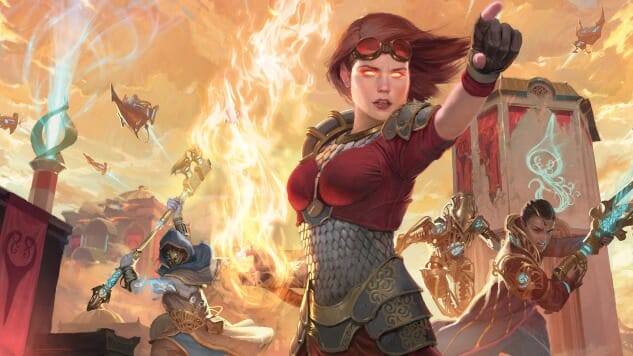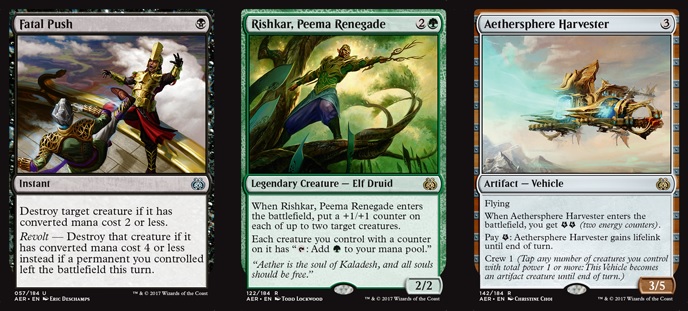
If you’ve ever played Magic: The Gathering, you know to be afraid of artifacts. Whether you slung some powerful free spells back in the 1990s or lived through the multiple “combo winters” of the turn of the millennium, you probably know that artifacts are often a place where the design of Magic goes awry. Even if you’ve only played a couple games, you’ve probably seen them: They’re grey in color, fit into any deck, and in the fiction of the game they are powerful machines that give access to abilities and effects that cannot be bounded by the different colors of mana that infuse the game world with magical energy.
Kaladesh, the most recent card set (called a “block”) of Magic, is what’s known as an “artifact block.” As creative team member Kimberly Kreines explained to me last year, the world of Kaladesh is one of constant development and invention. It is a place where people are putting all of their energy into creating devices that they think will make the world better in some way (at least theoretically). That means that there are lots of artifact cards, cards that care about artifacts, and generally just interesting ways of thinking about machinery and what machines can do within the wide world of Magic.
When the world of Kaladesh was opened up to players last fall, big events happened. Deck builders flocked to artifact cards like Aetherflux Reservoir, Smuggler’s Copter, Dynavolt Tower and the (extremely powerful) Aetherworks Marvel in order to generate very fast, very efficient and very splashy win conditions for their decks. Some were more silly and fun than others, but each of these strategies had the same basic structure: Get your artifact on the battlefield and execute your plan quickly. These strategies were dominant in casual and competitive play, and many of them won so quickly that a slight misplay on the part of an opponent would mean that they had no chance of recovering. It was not, as they say, “fun.”
Aether Revolt, the newly-released second half of the Kaladesh block, is an answer to Kaladesh in many ways. Where the first part of the block was invention and discovery, the second half is breaking things and revolutionizing the way power is held on that world. From a mechanical standpoint, some of those mechanics are very clear in cards like Fatal Push or Rishkar, Peema Renegade. The “Revolt” mechanic, new to this set, is focused on cards leaving the battlefield either in tactical retreat or through violent destruction. From top to bottom, Aether Revolt wants to (pardon this pun) revolutionize the way that Magic works right now.

It’s unclear at this point if that can happen, though. If you’re not aware, there are three kinds of ways to play a Magic set: Constructed, Sealed and Draft. In the first, you build a deck on your own time and then play it with friends or in tournaments. In the second, you open packs of cards, build a deck with those specific cards, and then play with that small card pool. In the third, you open packs, choose cards and then trade the packs around until everyone runs out of cards. Each of those different ways of playing the game takes different skills, and each of them are fun in their own specific way.
However, due to various problems, each of these ways of playing the game are impacted in a negative way with Aether Revolt. Playing constructed Magic leaves you playing against powerful artifacts in some games, hyper-synergistic giant creatures, or a literal infinite combo in others. Playing any kind of limited game, which encompasses Sealed and Draft play, means that you are always at the mercy of a player who opens a more powerful artifact than you. In Magic, there are often “bomby” sets. Put simply, there are some cards, often rare ones referred to as “bombs,” that are just better than most of the others, and if you open them in a limited game you will probably win more often than someone who didn’t open one. The benefit to Magic’s five different resource colors is that there are deck restrictions that come with those bombs. If you open a Verdurous Gearhulk, you need to play a green deck to actually use it.
However, many of the cards I listed above as well as all-star cards like Aethersphere Harvester, Walking Ballista and Heart of Kiran are able to fit into almost any deck due to their artifact status. Without a mana cost associated with a color, there is no significant check on their playability in any given deck, and sitting across the table from any one of those cards feels like a brutal beating.
I’ve enjoyed almost every play session from the past couple sets of Magic, but I will say that Kaladesh and Aether Revolt have been real disappointments for me. The power level of the cards is swingy in actual play with friends, and lack of clear synergies means that it is hard for a normal, not-super-invested player to develop decks outside the game and board states within the game to fight against the powerful and punishing outlier cards in the set. I can’t say I would recommend this set for new players or people returning to the game.
Cameron Kunzelman tweets at @ckunzelman and writes about games at thiscageisworms.com. His latest game, Epanalepsis, was released last year. It’s available on Steam.